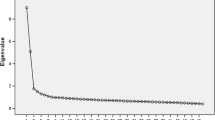Abstract
This paper presents an exploratory factor analysis (EFA) of a road safety behavior survey instrument prior to be used for collecting a Structural Equation Modelling (SEM) data. Through a self-administered survey, the data obtained from 100 respondents were analyzed using EFA to measure the survey instrument reliability. The questionnaire consisted of 14 items with responses recorded on a 10-point Likert scale. The results indicated that Kaiser-Meyer-Olkin values obtained for the three constructs measured, Road Violations, Cognitive Errors and Action Errors were 0.767, 0.865 and 0.872 respectively. For Bartlett’s Test of Sphericity, the results were found to be statistically significant. In addition, the Cronbach’s alpha was 0.922 (road violations), 0.959 (cognitive error) and 0.958 (action errors) which strongly suggest that all three constructs were within the required range of internal consistency. The results indicate that the questionnaire is valid and reliable tool for measuring driving errors due to distracted driving behavior.
Access this chapter
Tax calculation will be finalised at checkout
Purchases are for personal use only
Similar content being viewed by others
References
Atchley P, Atwood S, Boulton A (2011) The choice to text and drive in younger drivers: Behavior may shape attitude. Accid Anal Prev 43:134–142
Bentler PM, Kano Y (1990) On the equivalence of factors and components. Multivar Behav Res 25(1):67–74
Burton LJ, Mazerolle SM (2011) Survey instrument validity part I: principles of survey instrument development and validation in athletic training education research. Athlet Training Educ J 6(1):27–35
Caird K, Johnston KA, Willness CR, Asbridge MM, Steel P (2014) A meta-analysis of the effects of texting on driving. Acc Anal Prevent 71:311–318
Cattell RB (1966) The scree test for the number of factors. Multivar Behav Res 1(2):245–276
Field A (2006) Reliability analysis. Research methods II, pp 1–7
Gliklich E, Guo R, Bergmark RW (2016) Texting while driving: a study of 1211 US adults with the distracted driving survey. Prevent Med Rep 4:486–489
Golob TF (2003) Structural equation modeling for travel behavior research. Transp Res Part B: Methodological 37(1):1–25
Gorsuch R (1983) Factor analysis 2nd edn. Lawrence Erlbaum Associates, Hillsdale, NJ
Habing B (2003) Exploratory factor analysis. Retrieved from http://people.stat.sc.edu/habing/courses/530EFA.pdf
Hair JF Jr, Black WC, Babin BJ, Anderson RE (2010) Multivariate data analysis, 7th edn. Pearson Prentice Hall, Upper Saddle River, New Jersey
Hair JF Jr, Hult GTM, Ringle C, Sarstedt M (2016) A primer on partial least squares structural equation modeling (PLS-SEM). Sage Publications
Hair JF Jr, Black WC, Babin BJ, Anderson RE, Tatham RL (2006) Multivariate data analysis, 6th edn. Pearson Prentice Hall, Upper Saddle River, New Jersey
Hosking SG, Young KL, Regan MA (2009) The effects of text messaging on young drivers. Hum Factors 51:582–592
Humphreys LG (2016) Number of cases and number of factors: an example where N is very large. Educ Psychol Measur 24(3):457–466
Kline P (1979) Psychometrics and psychology. Acaderric Press, London
Koufteros XA (1999) Testing a model of pull production: a paradigm for manufacturing research using structural equation modeling. J Oper Manage 17(4):467–488
Li W, Gkritza K, Albrecht C (2014) The culture of distracted driving: evidence from a public opinion survey in Iowa. Transp Res Part F: Traffic Psychol Behav 26:337–347
MacCallum RC, Widaman KF, Zhang S, Hong S (1999) Sample size in factor analysis. Psychol Methods 4(1):84
Nemme HE, White KM (2010) Texting while driving: psychosocial influences on young people’s texting intentions and behaviour. Accid Anal Prev 42(4):1257–1265
Owens JM, McLaughlin SB, Sudweeks J (2011) Driver performance while text messaging using handheld and in-vehicle systems. Accid Anal Prev 43(3):939–947
Pallant J (2013) SPSS survival manual. McGraw-Hill Education, UK
Papantoniou P (2015) Risk factors, driver behaviour and accident probability: the case of distracted driving. Ph.D. Thesis, National Technical University of Athens, Athens, Greece
Pearson RH, Mundform DJ (2010) Recommended sample size for conducting exploratory factor analysis on dichotomous data. J Mod Appl Stat Methods 9(2):359–368
Rajesh R, Srinath R, Sasikumar R, Subin B (2017) Modeling safety risk perception due to mobile phone distraction among four wheeler drivers. IATSS Res 41(1):30–37
Rowe R, Roman GD, McKenna FP, Barker E, Poulter D (2015) Measuring errors and violations on the road: a bifactor modeling approach to the driver behavior questionnaire. Accid Anal Prev 74:118–125
Scheaffer RL, Mendenhall III W, Ott RL, Gerow KG (2011) Elementary survey sampling. Cengage Learning
Schumacker RE, Lomax RG (2004) A beginner’s guide to structural equation modelling, 2nd edn. Lawrence Erlbaum Associates, Inc., Publishers, Mahwah, New Jersey
Tabachnick BG, Fiddell LS (2012) Using multivariate statistics 6th edn. Pearson Education, Inc, Upper Saddle River, New Jersey
Ullman JB (2013) Structural equation modeling. In Tabachnick BG, Fiddell LS (eds) using multivariate statistics 6th edn. Pearson Education, Inc, Upper Saddle River, New Jersey, p 687
Velicer WF, Fava JL (1998) Affects of variable and subject sampling on factor pattern recovery. Psychol methods 3(2):231
Young KL, Salmon PM, Cornelissen M (2013) Distraction-induced driving error: an on-road examination of the errors made by distracted and undistracted drivers. Accid Anal Prev 58:218–225
Zainudin A (2012) Research methodology and data analysis 2nd edn. Universiti Teknologi MARA Publication Centre (UiTM Press), Shah Alam
Zainudin A (2015) SEM made simple: a gentle approach to learning structural equation modeling. MPWS Rich Publication Sdn. Bhd, Bandar Baru Bangi, Selangor
Zainudin A, Afthanorhan A, Mamat M (2016) The likert scale analysis using parametric based Structural Equation Modeling (SEM). Comput Methods Soc Sci 4(1):13–21
Acknowledgements
The authors would like to acknowledge the Ministry of Higher Education (MoHE) Malaysia for the FRGS Grant No. FRGS/1/2016/TK08/UNIMAS/02/1.
Author information
Authors and Affiliations
Corresponding author
Editor information
Editors and Affiliations
Rights and permissions
Copyright information
© 2020 Springer Nature Switzerland AG
About this paper
Cite this paper
Kabit, M.R., Lee, M.M.S., Zulkiply, N. (2020). Construct Reliability of Structural Equation Modelling (SEM) Exploratory Factor Analysis for a Distracted Driving Behavior Survey. In: Mohamed Nazri, F. (eds) Proceedings of AICCE'19. AICCE 2019. Lecture Notes in Civil Engineering, vol 53. Springer, Cham. https://doi.org/10.1007/978-3-030-32816-0_128
Download citation
DOI: https://doi.org/10.1007/978-3-030-32816-0_128
Published:
Publisher Name: Springer, Cham
Print ISBN: 978-3-030-32815-3
Online ISBN: 978-3-030-32816-0
eBook Packages: EngineeringEngineering (R0)




